The development blueprint for Ethereum in 2024 demonstrates its clear vision for the future.
Author: FRANCESCO
Translation: DeepTechFlow
In the world of cryptocurrency, Ethereum, as a key platform, has been continuously evolving and innovating. This article will delve into the important contents of the 2024 Ethereum development roadmap, including several key technical proposals such as ERC-4337, EIP-4844, EIP-3074, and EIP-5003, to understand how they will enhance Ethereum's scalability and user experience.

On Twitter, I have never seen so many anti-Ethereum remarks.
Almost every other day, a new L1 suspected to be an "Ethereum killer" appears, but Ethereum doesn't care. It remains steadfast, focusing on its own growth and improvement.
Ethereum's commitment to development is evident in the recently released 2024 Ethereum roadmap, which focuses on key developments aimed at improving scalability and user experience.

Among them, the date for EIP-4844 has been finalized, which will make it much easier to publish data on Ethereum's L2. Despite increasing competition, these new ERCs and EIPs will significantly enhance Ethereum's scalability and user experience.
Now, let's delve into these exciting updates, including ERC-4337, EIP-4844, EIP-3074, and EIP-5003.
ERC-4337: Revolutionizing Smart Contract Wallets
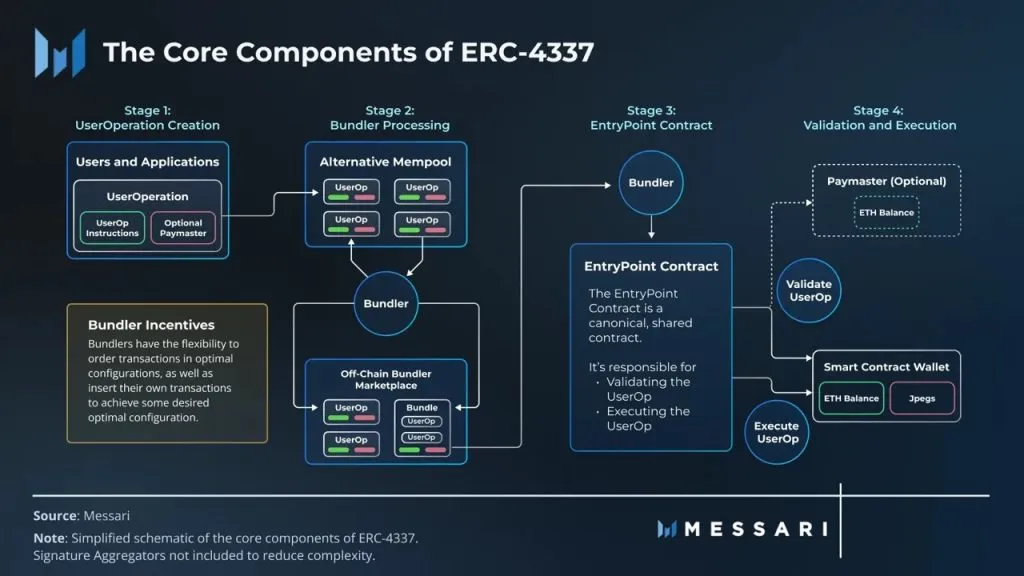
The introduction of the ERC-4337 standard marks a significant leap in the evolution of smart contract wallets. This improvement introduces a new concept called "account abstraction."
ERC-4337 is a proposal for account abstraction that completely avoids the need for changes in the consensus layer protocol. This proposal does not add new protocol features or change underlying transaction types; instead, it introduces a high-level pseudo-transaction object called UserOperation. For more information about ERC-4337, click here for details.
Traditionally, Ethereum accounts are divided into externally owned accounts (EOA) and smart contract accounts. However, user operations with EOA typically pose challenges in terms of usability and security.
ERC-4337 blurs these boundaries, allowing users to interact more intuitively with smart contracts.

The way users interact with Ethereum needs improvement to cope with an increasingly complex environment. We have already seen the emergence of solutions based on account abstraction, such as Creso Wallet and Avocado Wallet.
The introduction of ERC-4337 will lay the foundation for a series of improvements in wallet design and reduce end-user complexity.
In addition, ERC-4337 significantly improves the end-user experience and enables new possibilities, such as gas-free transactions or social logins and password recovery.
Key features of ERC-4337 include:
Enhanced security: By integrating more complex logic into the wallet, users can set transaction conditions, such as multi-factor authentication or daily spending limits.
User-friendly: It simplifies non-technical users' interactions, making the Ethereum ecosystem more accessible.
Gas fees in tokens: Users may pay transaction fees with tokens other than ETH, increasing convenience.
EIP-4844: Improving L2 Efficiency
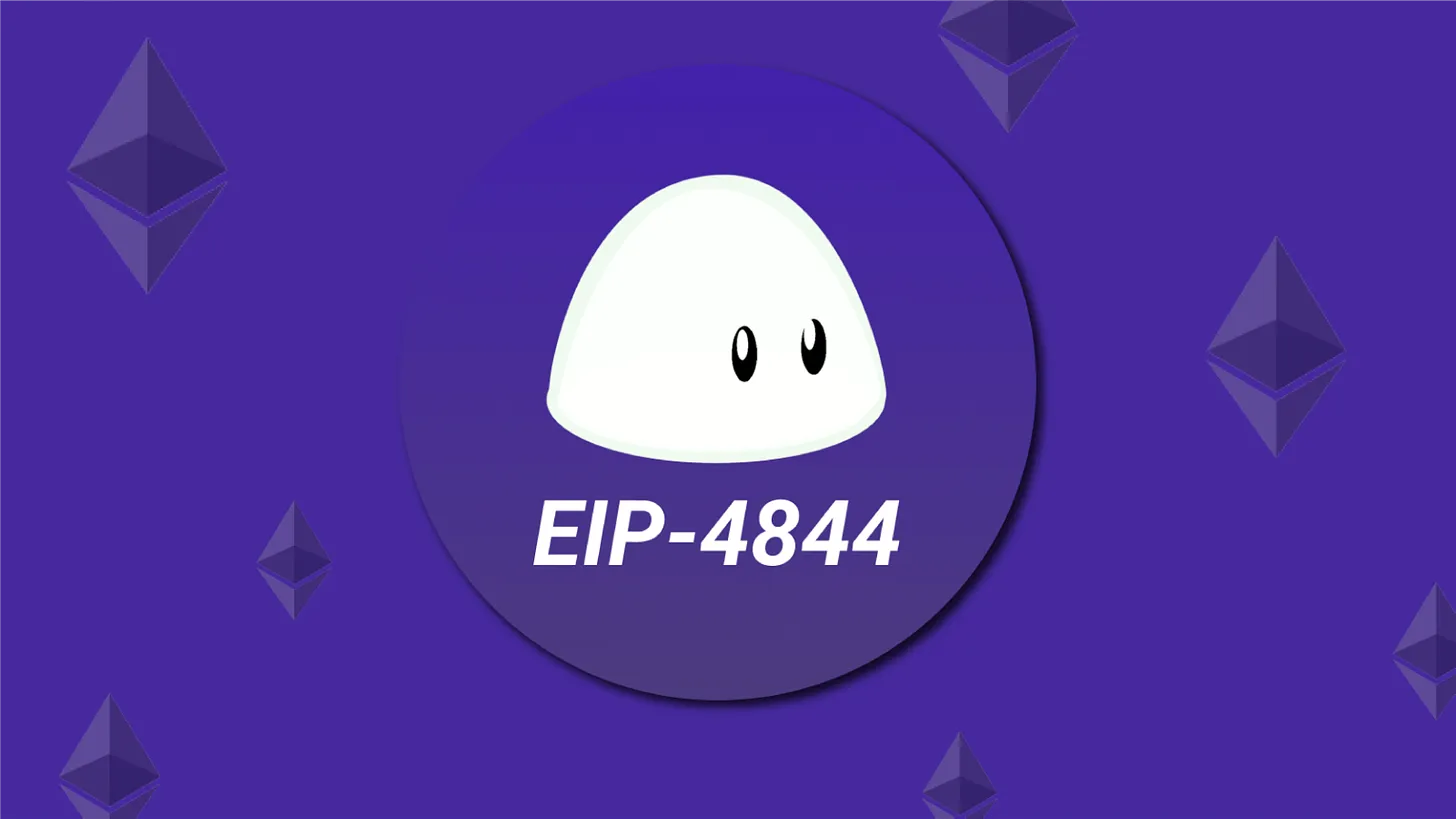
Why EIP-4844: Its purpose is to provide a low-cost way for L2 solutions to publish data on Ethereum and significantly reduce the overall transaction fees paid by users on L2.
Issue: L2 is generating increasing amounts of data. If there were a way to cheaply publish this data, it would immediately reduce the transaction fees charged to users on the network.
Solution: Introduce a new transaction format for "carrying blobs of data." It contains a large amount of data that "EVM execution cannot access, but can access its commitment." The content of the blob is not embedded in the body but is propagated separately as a "sidecar."
EIP-4844, commonly referred to as "proto-danksharding," is a significant advancement in addressing Ethereum's scalability issues. It introduces a new transaction type that allows the use of "shard blobs" for temporary data used by L2 solutions (such as Rollup).
EIP-4844 introduces a new transaction type for Ethereum that accepts "blob" data and temporarily stores it in beacon nodes.
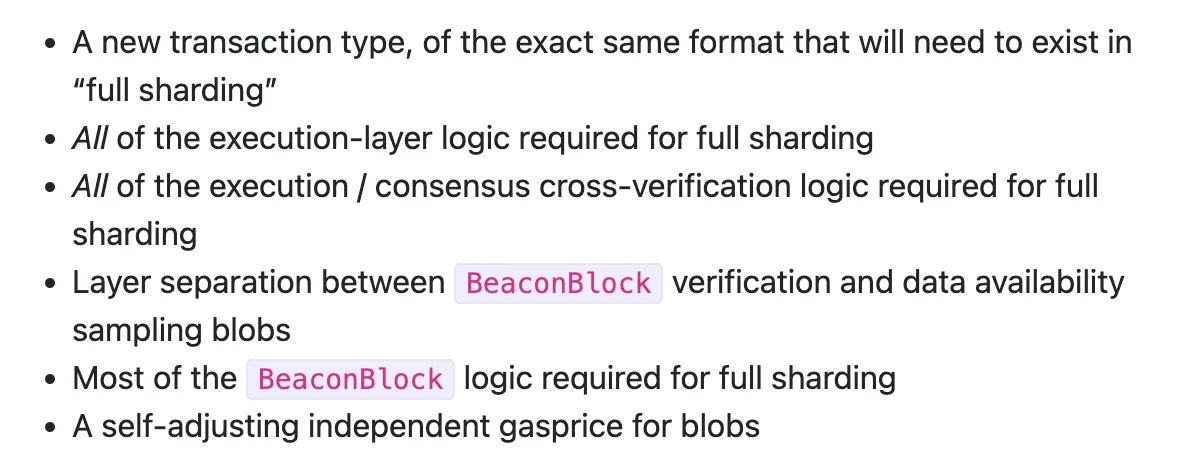
Shard blocks do not contain transactions executed in Ethereum blocks, but only "blobs of data," and L2 is responsible for using this data space to create a secure and more scalable experience for users.

The significance of EIP-4844 lies in its value to users, as we will all benefit from lower L2 fees.
Why will L2 fees be lower?
EIP-4844 separates transaction computation and storage costs, and L2 will use different functions to submit "blobs" to Ethereum.
They do not use "CALLDATA" to permanently store data but use blobs, which will be pruned after a predefined period.
Blobs of data do not need to be permanently available, but must be available for a certain period (e.g., 1-3 months), long enough for L2 to ensure that at least one honest actor can rebuild the state and challenge or replace bad sequencers. Then the data will be pruned.
EIP-4844 allows Rollup to initially expand to 0.25 MB per slot and provides a separate fee market for blobs, making the fees very low and significantly reducing the scale of Rollup expansion.
Potential impacts of EIP-4844
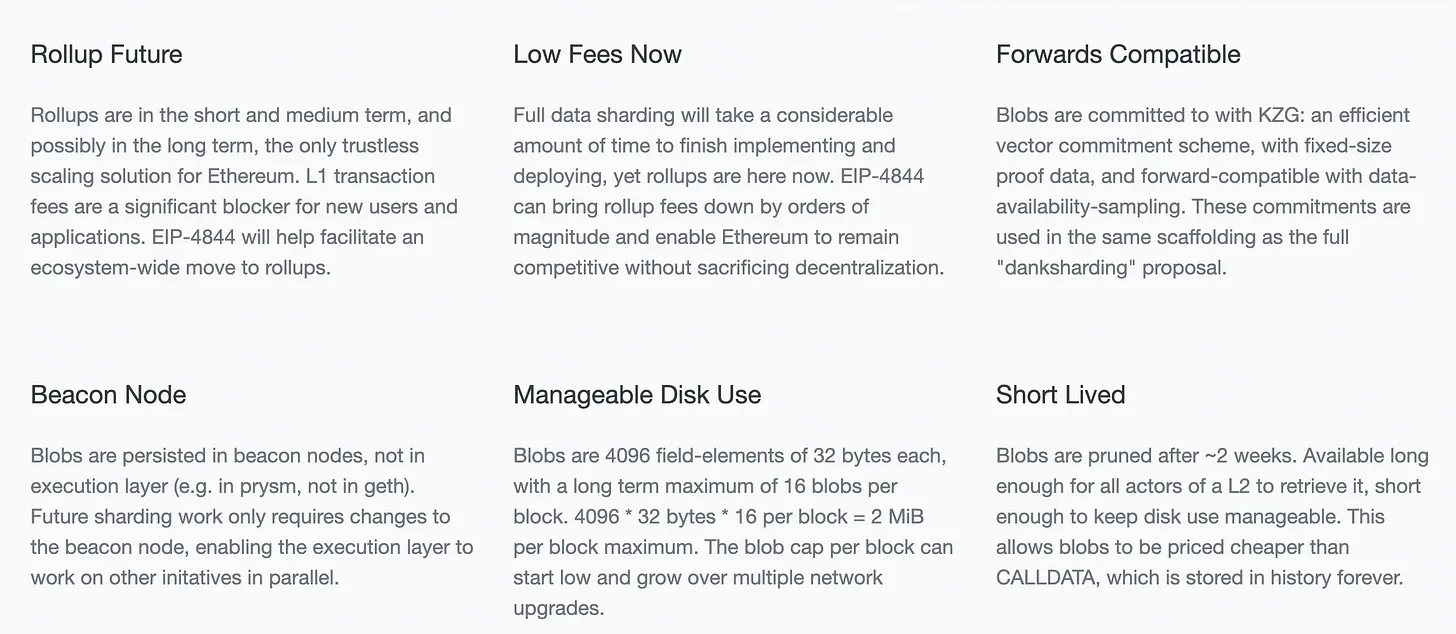
EIP-4844 has many potential impacts:
Lower L2 costs: By reducing data costs, L2 solutions become more economical, encouraging wider adoption.
Increased transaction throughput: This could lead to a more scalable network capable of handling more transactions.
Enhanced user experience: With faster and cheaper transactions, the overall user experience on Ethereum is greatly improved.
I previously wrote a detailed article on this topic, click here to read it in detail.
EIP-3074: Simplifying Transactions

EIP-3074 is a new concept that will open the doors to a more seamless user experience on Ethereum without the need for additional trust assumptions.
EIP-3074 fundamentally changes the authorization and execution of transactions on Ethereum. The proposal allows users to authorize third parties to execute transactions on their behalf using a new type of operation.
EIP-3074 aims to update Ethereum's EOA to allow them to delegate control to smart contracts—enabling smart contracts to approve transactions originating from user accounts.
In essence, EIP-3074 will allow complex operations to be executed with a single signature, without the need for multiple approvals, greatly improving the user experience and enabling seamless execution of complex operations. End users will be able to send batch transactions, expired transactions, and more. For more information about EIP-3074, click here for details.
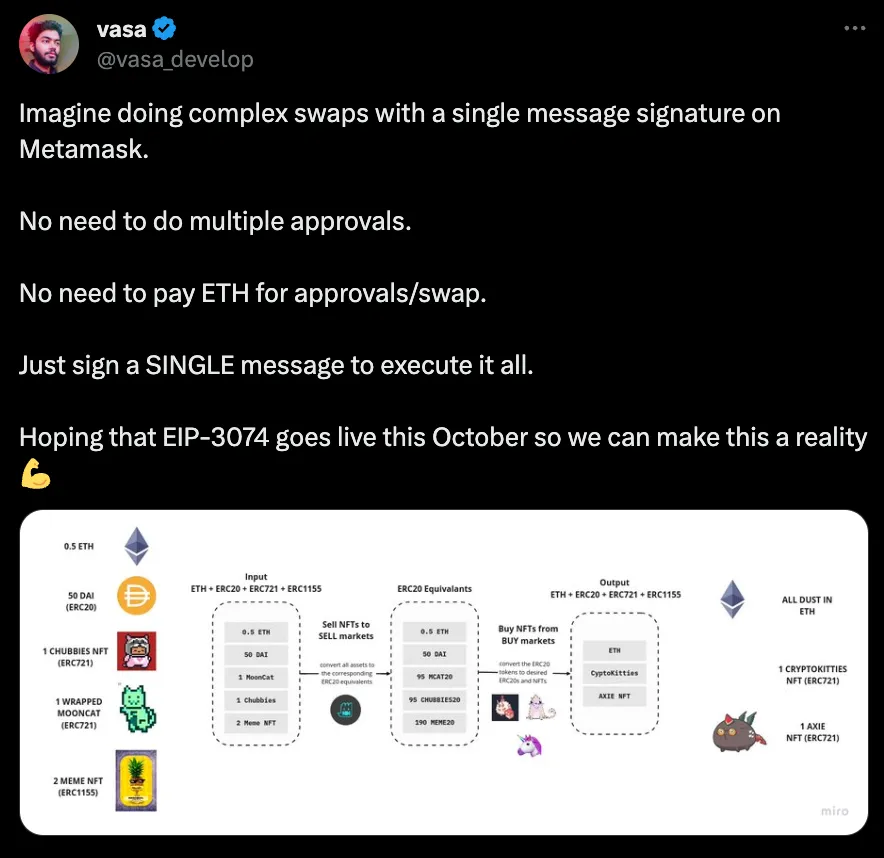
However, to achieve this, modifications to the Ethereum protocol are required, using two new EVM opcodes: AUTH and AUTHCALL.
Therefore, EIP-3074 is generally less favored compared to other account abstraction proposals (such as EIP-4337). Click here to learn more about concerns regarding EIP-3047.
Nevertheless, EIP-3074 will introduce new use cases, such as:
- Smart contract wallets: Never lose funds with wallet recovery solutions
- Batch transactions: Save on gas costs
- Automation: Achieve transaction automation with smart contract accounts
Advantages of EIP-3074 include:
- Simplified user interaction: Particularly beneficial for complex DApp interactions, reducing user steps and gas costs
- Increased developer flexibility: This can enable more creative and efficient smart contract designs
- Potential security enhancements: While it introduces new security considerations, it also provides an opportunity to establish stronger security mechanisms
EIP-5003: Network Resource Optimization
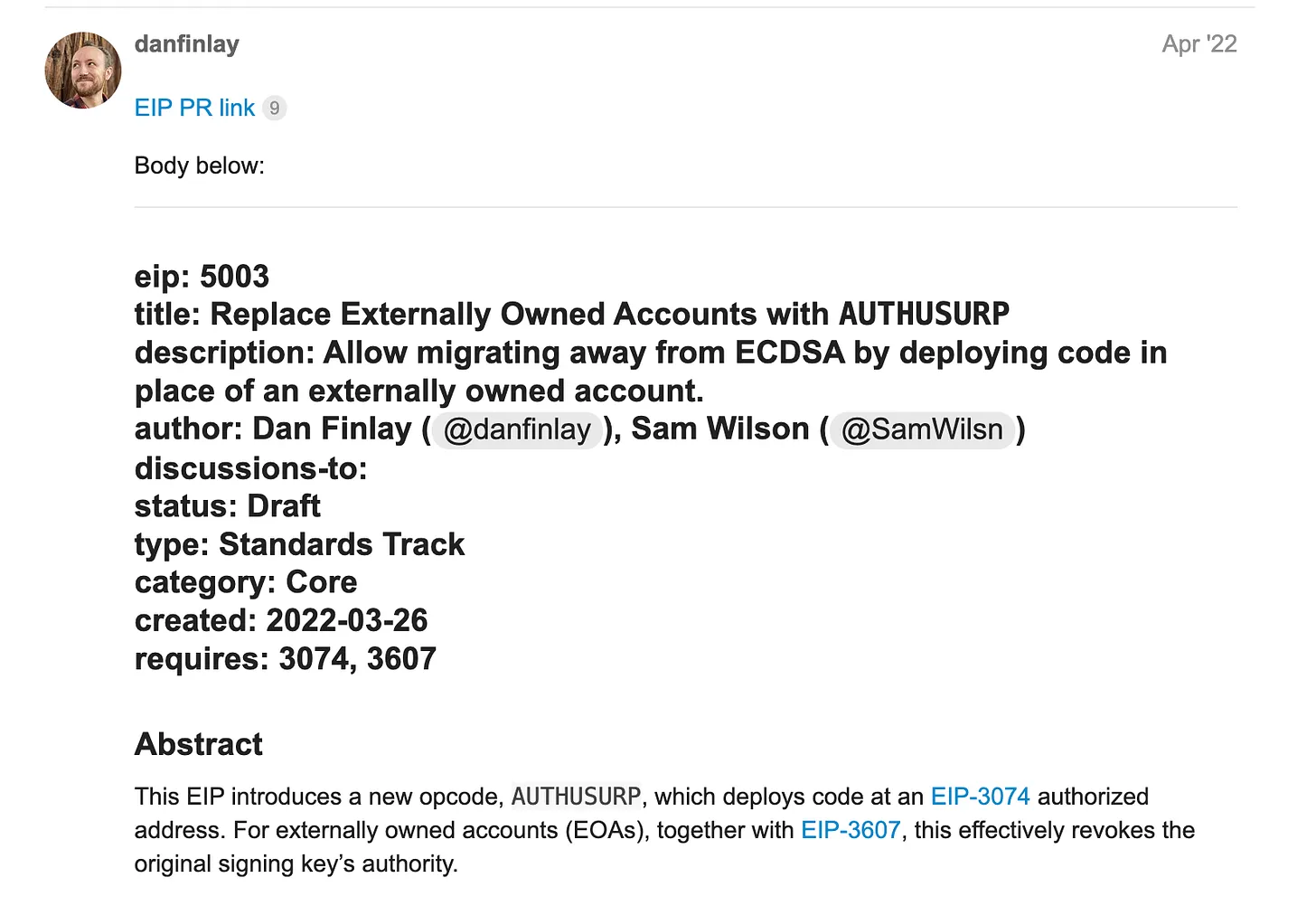
This proposal aligns well with EIP-3074, which provides the "opcodes" for delegating EAO signature permissions to smart contracts.
EIP-3074 authorizes smart contracts, while EIP-5003 completely migrates the signature keys of Ethereum EOA accounts to smart contract accounts.
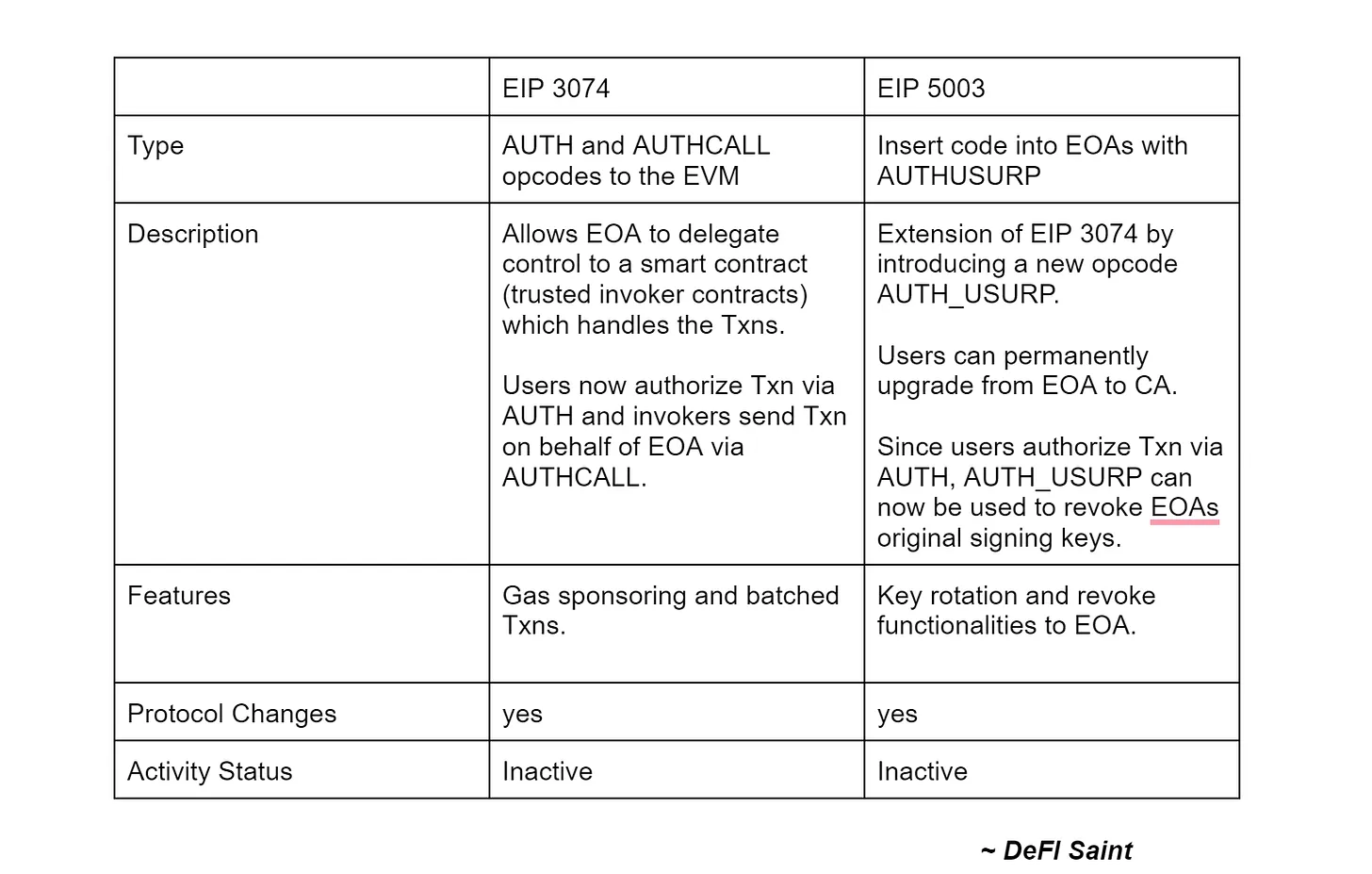
Applying EIP-3074 to a limited scope only will create new attack vectors around delegating permissions to smart contracts.
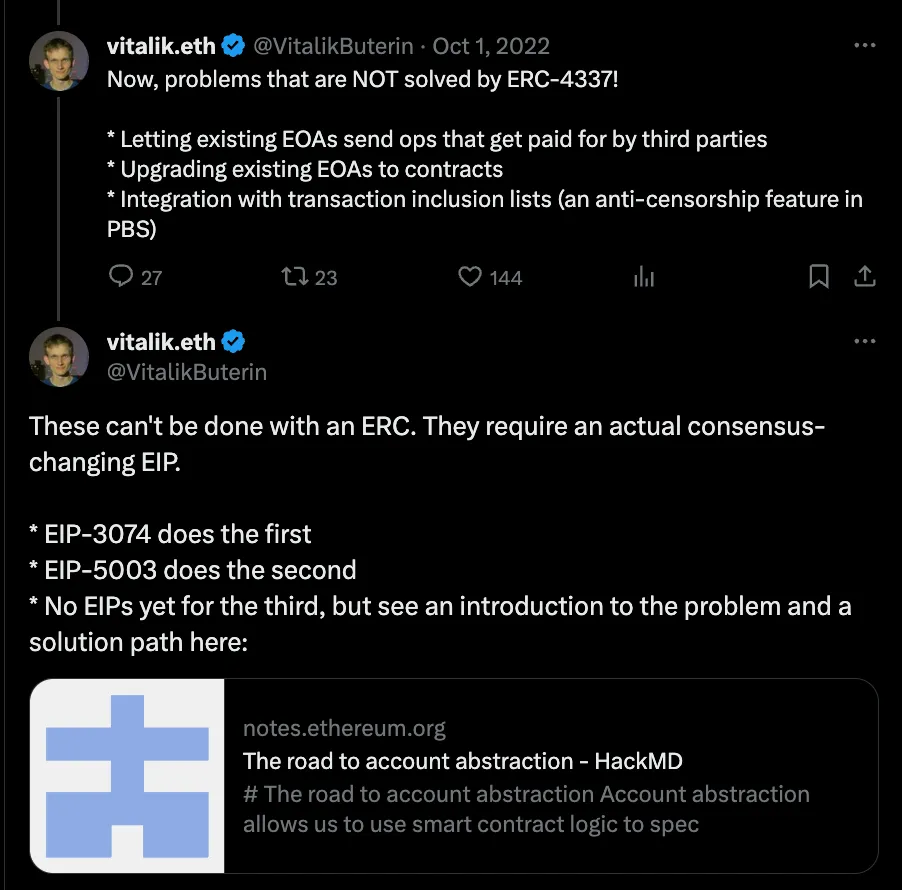
While EIP-5003 is less known, it plays a crucial role in enhancing Ethereum network efficiency and security.
Expected benefits of EIP-5003 include:
- Enhanced security: This EIP, combined with EIP-3074, addresses its drawbacks and ensures that the account abstraction migration does not create new attack vectors.
- Migration from EOA: This EIP represents the final migration from EOA.
Conclusion: Ethereum for the Future
While Ethereum's development is often seen as slow and security-first, Ethereum is not stagnant and it is incorrect to observe and evaluate its technology based on a specific moment, as it is always changing. It continues to evolve and improve.
In particular, the 2024 Ethereum development blueprint demonstrates its clear vision for the future and its commitment to addressing key areas such as scalability, security, accessibility, and usability, ensuring that the network is future-oriented.
The blueprint focuses on redefining the way users interact with Ethereum, transitioning from EOA accounts to more flexible smart contract wallets.
The implementation of ERC-4337, EIP-4844, EIP-3074, and EIP-5003 all play crucial roles in this evolution:
- ERC-4337 fundamentally changes smart contract wallets through account abstraction, providing enhanced security and user-friendliness. The standard aims to significantly simplify the user experience and expand the accessibility of the Ethereum ecosystem.
- EIP-4844, or "proto-danksharding," is a breakthrough in reducing costs and improving the efficiency of L2 solutions. By introducing a new transaction format for carrying blobs, it is expected to lower transaction fees and increase throughput, benefiting end users with more affordable and faster transactions.
- EIP-3074 and EIP-5003 together represent an important step in simplifying transactions and optimizing network resources. While EIP-3074 introduces new operation functions for authorizing transactions, EIP-5003 complements it by transitioning signature permissions from externally owned accounts (EOA) to smart contract accounts, enhancing network security and efficiency.
The main purpose of this article is to encourage readers to view Ethereum as a dynamic network that is constantly evolving and changing, rather than a static network, actively working towards being an emerging technology and alternative for the future.
We will continue to monitor the implementation of EIPs and Ethereum's development process this year.
免责声明:本文章仅代表作者个人观点,不代表本平台的立场和观点。本文章仅供信息分享,不构成对任何人的任何投资建议。用户与作者之间的任何争议,与本平台无关。如网页中刊载的文章或图片涉及侵权,请提供相关的权利证明和身份证明发送邮件到support@aicoin.com,本平台相关工作人员将会进行核查。




